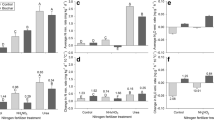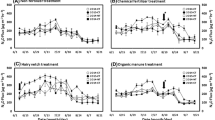Abstract
To investigate the influence of crop residues decomposition on nitrous oxide (N2O) emission, a field study was performed with application of crop residues with different C:N ratios in a bare yellow brown soil at the experimental station of Zhangjiachong at Zigui, China. We set up six experimental treatments: no crop residue (CK), rapeseed cake (RC), potato stalk (PS), rice straw (RS), wheat straw (WS), and corn straw (CS). The carbon (C) to nitrogen (N) ratios of these crop residues were 7.5, 32.9, 40.4, 65.7, and 90.9, respectively. Nitrous oxide fluxes were measured using a static closed chamber method. N2O emissions were significantly enhanced by incorporation of crop residues. Cumulative N2O emissions negatively correlated with C:N ratio (R 2 = 0.9821) of the crop residue, but they were positively correlated with average concentrations of dissolved organic carbon and microbial biomass carbon. Nitrogen emission fraction, calculated as N2O–N emissions originated from the crop residues N, positively correlated with C:N ratio of the residues (P < 0.05). Soil temperature did, whereas soil moisture did not, control the residue’s induced N2O emissions because a significant correlation (P < 0.01) existed between soil temperature and N2O emissions in all treatments except the control. In contrast, a significant relationship between soil moisture and N2O emissions was found in the control only. Furthermore, N2O emission significantly correlated (P < 0.05) with NO3 ––N, and NH4 +–N contents from all residue treatments. These results indicate that (1) crop residues with distinct carbon and nitrogen contents can significantly alter soil N2O flux rates; and (2) soil biotic as well as abiotic variables are critical in determining soil–atmospheric N2O emissions after crop residue incorporation into soil.







Similar content being viewed by others
References
Akiyama H, Tsuruta H (2003) Effect of organic matter application on N2O, NO and NO2 fluxes from an Andosol field. Glob Biogeochem Cycles 17:1100
Al-Sheikh A, Delgado JA, Barbarick K, Sparks R, Dillon M, Qian Y et al (2005) Effects of potato–grain rotations on soil erosion, carbon dynamics and properties of rangeland sandy soils. Soil Till Res 81:227–238
Aulakh MS, Doran JW, Walter DT, Mosier AR, Francis DD (1991) Crop residue type and placement effects on denitrification and mineralization. Soil Sci Soc Am J 55:1020–1025
Baggs EM, Rees RM, Smith KA, Winten AJA (2000) Nitrous oxide emission from soils after incorporating crop residues. Soil Use Manage 16:82–87
Baggs EM, Chebii J, Ndufa JK (2006) A short-term investigation of trace gas emissions following tillage and no-tillage of agroforestry residues in western Kenya. Soil Till Res 90:69–76
Burford JR, Bremner JM (1975) Relationships between denitrification capacities of soils and total, water-soluble and readily decomposable soil organic matter. Soil Biol Biochem 7:389–394
Chatskikh D, Olesen JE, Hansen EM, Elsgaard L, Petersen BM (2008) Effects of reduced tillage on net greenhouse gas fluxes from loamy sand soil under winter crops in Denmark. Agric Ecosyst Environ 128:117–126
Chirinda N, Carter MS, Albert KR, Ambus P, Olesen JE, Porter JR et al (2010) Emissions of nitrous oxide from arable organic and conventional cropping systems on two soil types. Agric Ecosyst Environ 136:199–208
Dalal RC, Wang W, Robertson GP, Parton WJ (2003) Nitrous oxide emission from Australian agricultural lands and mitigation options: a review. Aust J Soil Res 41:165–195
Dembreville C, Hallet S, Nguyen C, Morvan T, Germon JC, Philippot L (2006) Structure and activity of the denitrifying community in a maize-cropped field fertilized with composted pig manure or ammonium nitrate. FEMS Microbiol Ecol 56:119–131
Elmi AA, Madramootoo C, Hamel C, Liu A (2003) Denitrification and nitrous oxide to nitrous oxide plus dinitrogen ratios in the soil profile under three tillage systems. Biol Fertil Soils 38:340–348
Frimpong KA, Baggs EM (2010) Do combined applications of crop residues and inorganic fertilizer lower emission of N2O from soil? Soil Use Manage 26:412–424
Hadas A, Kautsky L, Goek M, Kara EE (2004) Rates of decomposition of plant residues and available nitrogen in soil, related to residue composition through simulation of carbon and nitrogen turnover. Soil Biol Biochem 36:255–266
Halvorson AD, Del Grosso SJ, Reule CA (2008) Nitrogen, tillage, and crop rotation effects on nitrous oxide emissions from irrigated cropping systems. J Environ Qual 37:1337–1344
Huang Y, Jiao Y, Zhong L, Wang Y, Sass RL (2002) Nitrous oxide emissions from the wheat-growing season in eighteen Chinese paddy soils: an outdoor pot experiment. Biol Fertil Soils 36:411–417
Huang Y, Zou J, Zheng X, Wang Y, Xu X (2004) Nitrous oxide emissions as influenced by amendment of plant residues with different C:N ratios. Soil Biol Biochem 36:973–981
IPCC (2007) In: Solomon S, Qin D, Manning M, Chen Z, Marquis M, Averyt KB et al (eds) Climate change 2007: the physical science basis. Contribution of Working Group I to the Fourth Assessment Report of the Intergovernmental Panel on Climate Change. Cambridge University Press, Cambridge
Iqbal J, Hu R, Du L, Lu L, Lin L, Chen T et al (2008) Differences in soil CO2 flux between different land use types in mid-subtropical China. Soil Biol Biochem 40:2324–2333
Iqbal J, Hu R, Lin S, Ahamadou B, Feng M (2009a) Carbon dioxide emissions from ultisol under different land uses in mid-subtropical China. Geoderma 152:63–73
Iqbal J, Hu R, Lin S, Hatanao R, Feng M, Lu L et al (2009b) CO2 emission in a subtropical red paddy soil (ultisol) as affected by straw and N-fertilizer applications: a case study in Southern China. Agric Ecosyst Environ 131:292–302
Iqbal J, Lin S, Hu R, Feng M (2009c) Temporal variability of soil CO2 and CH4 fluxes from different land uses in mid-subtropical China. Atmos Environ 43:5865–5875
Iqbal J, Hu R, Feng M, Lin S, Malghani S, Mohamed I (2010) Microbial biomass, and dissolved organic carbon and nitrogen strongly affect soil respiration in different land uses: a case study at three Gorges Reservoir Area, South China. Agric Ecosyst Environ 137:294–307
Jensen LS, Mueller T, Magid J, Nielsen NE (1997) Temporal variation of C and N mineralization, microbial biomass, and extractable organic pools in soils after oilseed rape straw incorporation in the field. Soil Biol Biochem 29:1043–1055
Kaiser EA, Kohrs K, Kücke M, Schnug E, Heinemeyer O, Munch JC (1998) Nitrous oxide release from arable soil: importance of N-fertilization, crops and temporal variation. Soil Biol Biochem 30:1553–1563
Knowles R (2000) Nitrogen cycle. In: Lederberg J (ed) Encyclopedia of microbiology, vol 3. Academic, San Diego, pp 379–391
Lin S, Iqbal J, Hu R, Feng ML (2010) N2O emissions from different land uses in mid-subtropical China. Agric Ecosyst Environ 136:40–48
Lin S, Iqbal J, Hu R, Wu J, Zhao J, Ruan L et al (2011) Nitrous oxide emissions from rape field as affected by nitrogen fertilizer management: a case study in Central China. Atmos Environ 45:1775–1779
Liu C, Zheng X, Zhou Z, Han S, Wang Y, Wang K et al (2010a) Nitrous oxide and nitric oxide emissions from an irrigated cotton field in Northern China. Plant Soil 332:123–134
Liu E, Yan C, Mei X, He W, Bing SH, Ding L et al (2010b) Long-term effect of chemical fertilizer, straw, and manure on soil chemical and biological properties in northwest China. Geoderma 158:173–180
Lou Y, Ren L, Li Z, Zhang T, Inubushi K (2007) Effect of rice residues on carbon dioxide and nitrous oxide emissions from a paddy soil of subtropical China. Water Air Soil Pollut 178:157–168
Mahmood T, Ali R, Iqbal J, Robab U (2008) Nitrous oxide emission from an irrigated cotton field under semiarid subtropical conditions. Biol Fertil Soils 44:773–781
Martín-Olmed P, Rees RM (1999) Short-term N availability in response to dissolved-organic-carbon from poultry manure, alone or in combination with cellulose. Biol Fertil Soils 29:386–393
Mary B, Recous S, Darwis D, Robin D (1996) Interactions between decomposition of plant residues and nitrogen cycling in soil. Plant Soil 181:71–82
Matson PA, Naylor R, Ortiz-Monasterio I (1998) Integration of environmental, agronomic, and economic aspects of fertilizer management. Science 280:112–115
Meijide A, García-Torres L, Arce A, Vallejo A (2009) Nitrogen oxide emissions affected by organic fertilization in a non-irrigated Mediterranean barley field. Agric Ecosyst Environ 132:106–115
Millar N, Baggs EM (2004) Chemical composition, or quality, of agroforestry residues influence N2O emissions after their addition to soil. Soil Biol Biochem 36:935–943
Millar N, Ndufa JK, Cadisch G, Baggs EM (2004) Nitrous oxide emissions following incorporation of improved-fallow residues in the humid tropics. Glob Biogeochem Cycles 18:GB1032
Mosier A, Kroeze C, Nevison C, Oenema O, Seitzinger S, Cleemput O (1998) Closing the global N2O budget: nitrous oxide emissions through the agricultural nitrogen cycle. Nutr Cycl Agroecosyst 52:225–248
Mulvaney RL, Khan SA, Mulvaney CS (1997) Nitrogen fertilizers promote denitrification. Biol Fertil Soils 24:211–220
Norton U, Mosier AR, Morgan JA, Derner JD, Ingram LJ, Stahl PD (2008) Moisture pulses, trace gas emissions and soil C and N in cheatgrass and native grass-dominated sagebrush-steppe in Wyoming, USA. Soil Biol Biochem 40:1421–1431
Palm CA, Sanchez PA (1991) Nitrogen release from the leaves of some tropical legumes as affected by their lignin and polyphenolic contents. Soil Biol Biochem 23:83–88
Paul EA, Clark FE (1996) Soil microbiology and biochemistry. Academic, New York
Petersen SO, Schjønning P, Thomsen IK, Christensen BT (2008) Nitrous oxide evolution from structurally intact soil as influenced by tillage and soil water content. Soil Biol Biochem 40:967–977
Quemada M, Cabrera ML (1995) Carbon and nitrogen mineralized from leaves and stems of four cover crops. Soil Sci Soc Am J 59:471–477
Robertson GP (1989) Nitrification and denitrification in humid tropical ecosystems: potential controls on nitrogen retention. In: Proctor J (ed) Mineral nutrients in tropical forest and savanna ecosystems. Blackwell Scientific, Boston, pp 55–70
Sanchez-Martin L, Sanz-Cobena A, Meijide A, Quemada M, Vallejo A (2010) The importance of the fallow period for N2O and CH4 fluxes and nitrate leaching in a Mediterranean irrigated agroecosystem. Eur J Soil Sci 61:710–720
Scheer C, Wassmann R, Kienzler K, Ibragimov N, Eschanov R (2008) Nitrous oxide emissions from fertilized, irrigated cotton (Gossypium hirsutum L.) in the Aral Sea Basin, Uzbekistan: influence of nitrogen applications and irrigation practices. Soil Biol Biochem 40:290–301
United States Environmental Protection Agency (2007) Draft U.S. greenhouse gas inventory report: DRAFT inventory of U.S. greenhouse gas emissions and sinks: 1990–2005. United States Environmental Protection Agency, Office of Atmospheric Programs (6207J), Washington, DC
Wang YS, Wang YH (2003) Quick measurement of CH4, CO2 and N2O emission from a short-plant ecosystem. Adv Atmos Sci 20:842–844
Wang Q, Xu F, Liu Z (1988) Tentative research on genetic characteristics of zonal soils in Hubei province. J Huazhong Agric Univ 7(4):349–358
Wu J, Jöergensen RG, Pommerening B, Chaussod R, Brookes PC (1990) Measurement of soil microbial biomass by fumigation-extraction—an automated procedure. Soil Biol Biochem 22:1167–1169
Yao Z, Zheng X, Xie B, Mei B, Wang R, Butterbach-Bahl K et al (2009) Tillage and crop residue management significantly affects N-trace gas emissions during the non-rice season of a subtropical rice-wheat rotation. Soil Biol Biochem 41:2131–2140
Zak DR, Grigal DF, Gleeson S, Tilman D (1990) Carbon and nitrogen cycling during old-field succession: Constraints on plant and microbial biomass. Biogeochemistry 11:111–129
Acknowledgments
This research was jointly supported by National Program on Key Basic Research Project of China (Grant No. 2012CB417106) and National Natural Science Foundation of China (Grant Nos. 41171212 and 41201255). The authors are grateful to the president and staff members of the experimental station of the experimental station of Zigui County, Three Gorges Reservoir Area, located in Hubei province, Central China, for their assistance in field data collection.
Author information
Authors and Affiliations
Corresponding author
Rights and permissions
About this article
Cite this article
Lin, S., Iqbal, J., Hu, R. et al. Nitrous Oxide Emissions from Yellow Brown Soil as Affected by Incorporation of Crop Residues With Different Carbon-to-Nitrogen Ratios: A Case Study in Central China. Arch Environ Contam Toxicol 65, 183–192 (2013). https://doi.org/10.1007/s00244-013-9903-7
Received:
Accepted:
Published:
Issue Date:
DOI: https://doi.org/10.1007/s00244-013-9903-7




